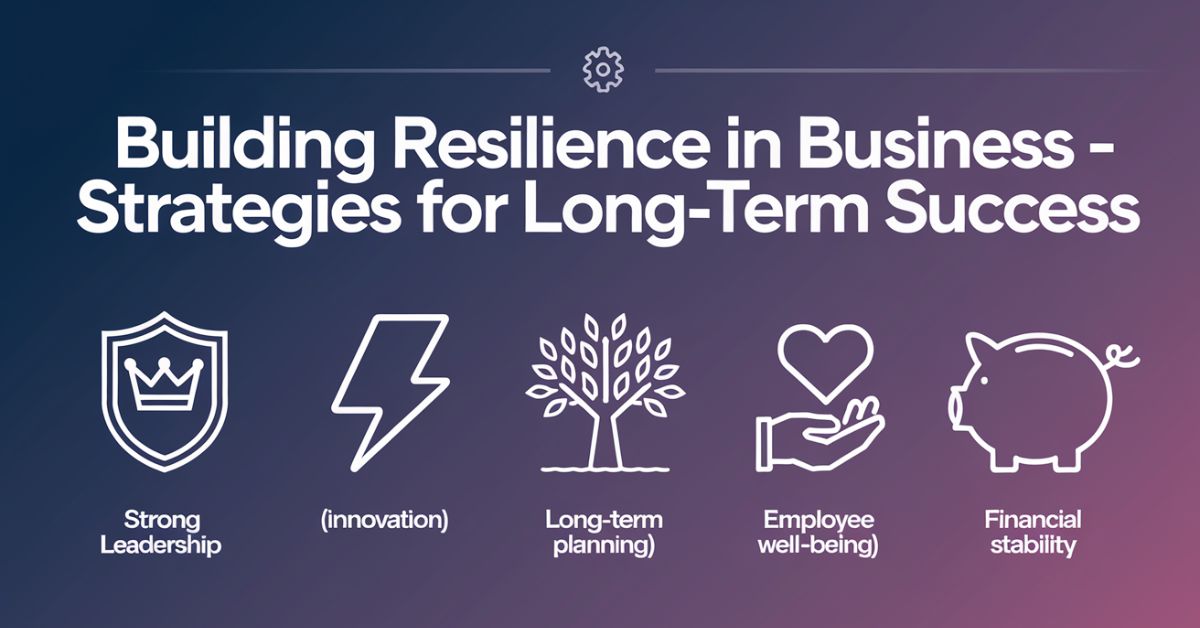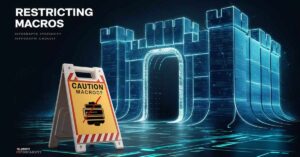In today’s volatile business landscape, building resilience isn’t just a buzzword—it’s a crucial strategy for long-term success. Companies that weather storms and come out stronger on the other side don’t just get lucky; they’ve cultivated resilience as a core competency. This article dives deep into the strategies that successful businesses use to build and maintain resilience, ensuring they’re not just surviving, but thriving in the face of challenges.
The Role of Higher Education in Strategic Resilience
When we talk about building resilience in business, higher education might not be the first thing that comes to mind. Yet, it plays a pivotal role in developing the kind of strategic thinking and adaptability that resilient businesses need.
Continuous Learning as a Cornerstone of Adaptability
In a world where change is the only constant, continuous learning isn’t just nice to have—it’s essential. Businesses that foster a culture of ongoing education are better equipped to adapt to new challenges and seize emerging opportunities.
Take, for example, the case of General Electric (GE). Despite being a century-old company, GE has managed to stay relevant by investing heavily in employee education. Their “GE Crotonville” leadership institute is renowned for developing adaptable leaders who can navigate complex business environments.
Here’s how continuous learning builds resilience:
- Keeps skills current: In fast-evolving industries, yesterday’s expertise can quickly become obsolete.
- Encourages innovation: Exposure to new ideas sparks creative problem-solving.
- Builds confident teams: Knowledgeable employees are more likely to tackle challenges head-on.
Developing Critical Thinking Skills
Higher education doesn’t just impart knowledge; it hones critical thinking skills that are crucial for business resilience. These skills enable leaders and teams to:
- Analyze complex situations from multiple angles
- Make decisions based on evidence rather than gut feeling
- Anticipate potential outcomes and plan accordingly
A prime example of this in action is IBM’s partnership with universities to develop its quantum computing program. By collaborating with academic institutions, IBM is not only advancing its technology but also cultivating a workforce with the critical thinking skills needed to solve future challenges in computing.
Fostering Innovation through Academic Collaboration
Resilient businesses don’t innovate in a vacuum. They tap into the wealth of knowledge and research capabilities that universities offer. This collaboration can take many forms:
- Joint research projects
- Internship programs
- Sponsored academic chairs
Procter & Gamble’s Connect + Develop program is a testament to the power of such collaborations. By partnering with universities and research institutions worldwide, P&G has been able to bring innovations to market faster and more efficiently, enhancing its resilience in a competitive consumer goods market.
Developing a Strong Financial Cushion
Building resilience in business isn’t just about strategies and skills—it’s also about cold, hard cash. A strong financial foundation can mean the difference between weathering a storm and being swept away by it.
The Importance of Cash Reserves
Having a healthy cash reserve is like having a life jacket in choppy waters. It provides buoyancy when revenue streams are disrupted and gives businesses the breathing room to make strategic decisions rather than panicked reactions.
Apple Inc. is famous for its massive cash reserves, which have allowed the company to:
- Invest in R&D during economic downturns
- Make strategic acquisitions
- Weather supply chain disruptions
While not every company can (or should) sit on billions like Apple, even smaller businesses can benefit from building a cash cushion. Financial experts often recommend having enough cash to cover 3-6 months of operating expenses.
Diversifying Revenue Streams
Putting all your eggs in one basket is risky business. Resilient companies spread their risk by diversifying their revenue streams. This could mean:
- Expanding into new markets
- Developing complementary products or services
- Creating passive income sources
Consider the case of Amazon. What started as an online bookstore has diversified into:
- E-commerce across multiple product categories
- Cloud computing services (AWS)
- Streaming entertainment
- Artificial intelligence and smart home devices
This diversification has made Amazon one of the most resilient companies in the world, able to offset losses in one area with gains in another.
Smart Debt Management
While too much debt can sink a company, strategic use of debt can enhance resilience. The key is to maintain a healthy debt-to-equity ratio and use debt to fund growth initiatives rather than cover operational losses.
Starbucks provides an excellent example of smart debt management. During the 2008 financial crisis, the company took on debt to fund a restructuring effort that included closing underperforming stores and improving efficiency. This strategic use of debt positioned Starbucks for strong growth in the years that followed.
Building a Flexible and Adaptable Workforce

A company’s resilience is only as strong as its workforce. Building a team that can pivot quickly and adapt to new challenges is crucial for long-term success.
Embracing Remote Work Models
The global shift to remote work during the COVID-19 pandemic was a stark reminder of the importance of workforce flexibility. Companies that had already embraced remote work models found themselves at a significant advantage.
GitLab, a software company that has been fully remote since its inception, serves as a model for building a resilient, distributed workforce. Their approach includes:
- Asynchronous communication to accommodate different time zones
- Regular virtual team-building activities
- Comprehensive documentation to ensure knowledge sharing
Upskilling and Reskilling Initiatives
In a rapidly changing business environment, the skills needed today might be obsolete tomorrow. Resilient businesses invest in continuous upskilling and reskilling of their workforce.
AT&T’s Future Ready initiative is a prime example. Faced with a shortage of workers with the skills needed for its transition to a 5G network, AT&T invested $1 billion in a massive retraining program. This proactive approach has helped the company build resilience by ensuring its workforce remains capable of meeting future challenges.
Cultivating a Culture of Adaptability
Resilience isn’t just about skills and processes—it’s also about mindset. Companies that foster a culture where change is viewed as an opportunity rather than a threat are better positioned to thrive in uncertain times.
Netflix is renowned for its adaptive culture. Their famous “Culture Deck” emphasizes:
- Freedom and responsibility
- Context, not control
- Highly aligned, loosely coupled teams
This culture has allowed Netflix to pivot successfully from DVD rentals to streaming to content production, demonstrating remarkable business resilience along the way.
Leveraging Technology for Operational Efficiency
In the digital age, technology is a key driver of business resilience. Companies that effectively leverage technology can adapt more quickly, operate more efficiently, and respond more effectively to challenges.
Automation and AI in Business Processes
Automation and artificial intelligence are no longer futuristic concepts—they’re essential tools for building resilient operations. By automating routine tasks and using AI for data analysis and decision-making, businesses can:
- Reduce errors and improve consistency
- Free up human resources for more strategic work
- Respond more quickly to changes in demand or market conditions
UPS has been a leader in leveraging AI for operational efficiency. Their ORION (On-Road Integrated Optimization and Navigation) system uses AI to optimize delivery routes, saving the company an estimated $300-400 million annually. This not only improves efficiency but also builds resilience by allowing UPS to adapt quickly to changes in traffic patterns or delivery volumes.
Cloud Computing and Scalability
Cloud computing has revolutionized the way businesses operate, offering unprecedented flexibility and scalability. Companies that leverage cloud services can:
- Scale operations up or down quickly in response to demand
- Access advanced technologies without significant upfront investment
- Improve collaboration and data sharing across the organization
Zoom’s ability to scale rapidly during the COVID-19 pandemic is a testament to the power of cloud computing. The company was able to handle a 30x increase in usage, growing from 10 million to 300 million daily meeting participants in a matter of months. Building Resilience in Business: Strategies for Long-Term Success.
Cybersecurity as a Resilience Strategy
As businesses become increasingly digital, cybersecurity becomes a critical component of resilience. A single data breach can cause significant financial and reputational damage.
Microsoft has made cybersecurity a cornerstone of its business resilience strategy. The company:
- Invests over $1 billion annually in cybersecurity research and development
- Provides advanced security features across its product line
- Offers cybersecurity training and resources to its customers
By prioritizing cybersecurity, Microsoft not only protects its operations but also builds trust with customers, enhancing its long-term resilience. Building Resilience in Business: Strategies for Long-Term Success.
Fostering Strong Customer Relationships
In times of crisis, strong customer relationships can be a lifeline for businesses. Companies that have built deep, lasting connections with their customers are more likely to retain their business and even gain advocates during challenging times.
Building Brand Loyalty Through Transparency
Transparency builds trust, and trust builds resilience. Companies that are open and honest with their customers, especially during difficult times, often find that this loyalty pays dividends.
Patagonia is renowned for its transparency, particularly regarding its supply chain and environmental impact. This openness has built a fiercely loyal customer base that supports the company even when it takes controversial stands on social and environmental issues. Building Resilience in Business: Strategies for Long-Term Success.
Personalization and Customer-Centric Approaches
In an age of data-driven insights, businesses that can offer personalized experiences have a significant advantage. By truly understanding and catering to individual customer needs, companies can build stronger, more resilient relationships. Building Resilience in Business: Strategies for Long-Term Success.
Netflix’s recommendation algorithm is a prime example of effective personalization. By tailoring content suggestions to individual viewing habits, Netflix keeps customers engaged and reduces churn, contributing to its overall business resilience.
Community Engagement and Social Responsibility
Businesses that engage with and support their communities often find that this goodwill translates into resilience during tough times. Companies that are seen as valuable community members are more likely to receive support when they need it most. Building Resilience in Business: Strategies for Long-Term Success.
TOMS Shoes built its entire business model around social responsibility with its “One for One” giving program. This commitment to social good has created a strong emotional connection with customers, helping the company weather challenges and changes in the competitive landscape.
Building Resilience in Business: Strategies for Long-Term Success Examples

Let’s look at some real-world examples of how companies across different industries have built resilience:
- Tech Industry: Microsoft’s transformation under Satya Nadella, pivoting from a Windows-centric company to a cloud and AI leader.
- Retail Sector: Best Buy’s successful adaptation to e-commerce competition through price matching, in-store experiences, and excellent customer service.
- Manufacturing: Toyota’s development of the Toyota Production System, has allowed the company to maintain efficiency and quality even in the face of supply chain disruptions.
Resilience Strategy Examples
Here are some specific strategies companies have used to build resilience:
- Crisis Management Plans: Johnson & Johnson’s handling of the Tylenol tampering crisis in 1982 is still studied as a model of effective crisis management.
- Scenario Planning: Royal Dutch Shell’s use of scenario planning has helped the company navigate the volatile energy market for decades.
- Cross-Functional Teams: Pixar’s use of “Braintrust” meetings, which bring together diverse perspectives to solve creative challenges.
Business Resilience
Building resilience is an ongoing process that requires commitment at all levels of an organization. Here are some key aspects to consider:
Measuring and Monitoring Resilience
To improve resilience, you need to be able to measure it. Some key performance indicators (KPIs) for business resilience include:
- Financial ratios (e.g., debt-to-equity, current ratio)
- Customer retention rates
- Employee engagement scores
- Time to recover from disruptions
The Role of Leadership in Fostering Resilience
Resilient organizations require resilient leaders. Characteristics of leaders who foster resilience include:
- Emotional intelligence
- Adaptability
- Transparent communication
- Long-term thinking
Jacinda Ardern, Prime Minister of New Zealand, demonstrated these qualities in her handling of the COVID-19 pandemic, contributing to the country’s resilient response.
Long-Term Vision vs. Short-Term Gains
Truly resilient businesses prioritize long-term sustainability over short-term profits. This might mean:
- Investing in employee development even during lean times
- Maintaining quality standards even when cutting costs
- Staying true to core values even when facing pressure to compromise
Costco’s decision to continue paying high wages and providing good benefits, even as competitors cut costs during economic downturns, has contributed to its long-term resilience and success.
FAQs
Q: What are resilience strategies in business?
Resilience strategies in business are approaches that help companies prepare for, respond to, and recover from challenges and disruptions. These can include:
- Diversifying revenue streams
- Building strong financial reserves
- Investing in employee skills and adaptability
- Leveraging technology for operational efficiency
- Cultivating strong customer relationships
Q: How to build resilience in a business?
Building resilience in a business involves:
- Assessing current vulnerabilities and strengths
- Developing a clear, long-term vision
- Investing in people and technology
- Creating flexible and adaptive processes
- Fostering a culture of continuous learning and improvement
- Regularly testing and updating crisis response plans
Q: What is a strategy for building resilience?
One effective strategy for building resilience is scenario planning. This involves:
- Identifying potential future scenarios (both positive and negative)
- Analyzing the potential impact of each scenario on the business
- Developing strategies to address each scenario
- Regularly reviewing and updating these plans
Q: What does building business resilience mean?
Building business resilience means creating an organization that can:
- Anticipate potential challenges and opportunities
- Adapt quickly to changing circumstances
- Recover effectively from setbacks
- Continue to grow and evolve in the face of uncertainty








